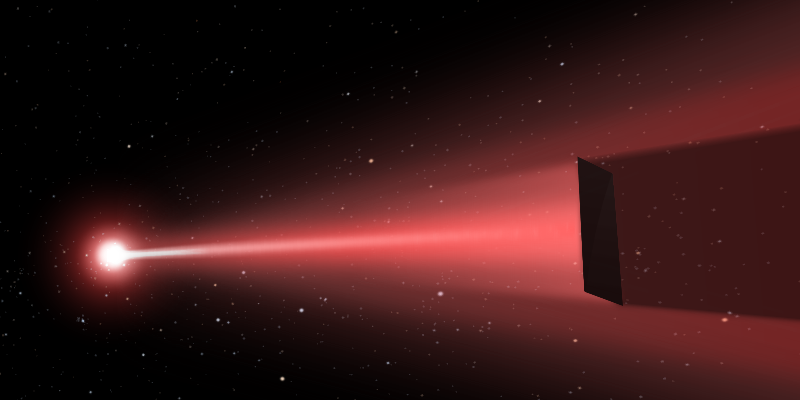What type of science can LaserSETI do?
SETI
The Search for Extraterrestrial Intelligence is, according to Wikipedia, “a collective term for scientific searches for intelligent extraterrestrial life.” Optical SETI is a subset of those searches looking for visible light signals that could be attributed to extra terrestrial intelligence, often presumed to be lasers because a narrow beam is essential if you’re going to send light a long distance efficiently.
It has long been speculated that powerful lasers might be used by advanced societies for interstellar communication. Messaging by light has a fundamental advantage over radio in that it can, in principle, convey far more bits per second – typically a half-million times as many. This increased bandwidth is a characteristic that would make lasers useful for communicating with off-world colonies, for example.
For decades, a small number of so-called optical-SETI projects have examined star systems for extremely brief (nanosecond) flashes of light that may indicate E.T. communication. However, the instruments used for these projects have all relied on photomultiplier tubes to detect the flashes, making them essentially one-pixel cameras. As a result, very little of the sky has been examined.
LaserSETI is trying to change that! Each LaserSETI detection device consists of two identical cameras. Each LaserSETI device uses cameras with a commercial lens that images approximately 75 degrees of sky onto off-the-shelf solid-state detectors. Therefore, with multiple LaserSETI observatories around the globe, all-sky monitoring is in reach.
These devices can tell monochromatic laser-like sources from natural sources by looking at their spectra. Behind each lens is a grating that transforms any light source in the camera’s field-of-view into a double rainbow-like spectrum. While stars will produce a complete spectrum from blue to red, a laser will only show up at its characteristic wavelength (think of your red laser pointer). Currently, there are no known monochromatic optical sources produced by nature, so any positive detection of laser-like sources would either indicate the presence of E.T., or just as important, a new type of astrophysical phenomenon. In this way, LaserSETI is paving the way for a new type of optical SETI search that watches the whole sky, all the time.

An example of how LaserSETI can distinguish the light from stars versus light from a monochromatic laser pulse. The “star” examples at the top of the image show how the different wavelengths of light coming from a star will be spread into a spectra by the grating within each LaserSETI unit. In contrast, a monochromatic pulse only consists of one wavelength of light and will not produce a full spectrum.
Beamed Energy Propulsion
One assumption often made by SETI searches is that the other civilization will be trying to contact us, but that isn’t the only reason to send signals bright enough to be seen from astronomical distances. Powerful lasers can also propel spacecraft to near-relativistic speeds and could conceivably be in widespread use for this purpose.
If an alien civilization was using this technology, perhaps propelling a space craft with “solar sails” using a laser, we may be able to detect that laser if it is pointed in our direction. So Laser and optical SETI is not limited to the discovery of intentional E.T. communication, but may one day reveal the presence of other lifeforms inadvertently.

Meteors
LaserSETI stations are not only capable of picking up on E.T. signals, but also other natural phenomena that we are familiar with – like meteors! Meteors are rocks, bits of dust, and other flotsam that enter Earth’s atmosphere and either burn up from friction or impact the ground. They can be rocks left over from the formation of the solar system or human-created objects such at defunct satellites.
One phenomenon regularly caught by meteor camera networks, like the CAMS Network, is called a “sky flash.” If you watch carefully in the video below, you’ll see a star appear to blink into and out of existence very rapidly. The best theory we’ve seen to explain these posits a meteor travelling straight towards the observer, but specifically one that’s too dim to be seen normally, i.e. from the side. If all the light produced by vaporizing in the atmosphere is stacked up along your line of sight, then it would appear much brighter. Meteors get exponentially more numerous as their size decreases and, as that happens, it takes less time to burn up. Hence, these events would be happening all time, but only be visible to a small footprint on the ground and be very easy to miss. But good science is more than just a good idea that fits the facts–we need evidence! And LaserSETI is the perfect instrument to get it.
Debris Re-Entry
Because LaserSETI will monitor such a large portion of the sky (it currently already monitors nearly 1/3 of the sky), it is in a prime position to watch for man made objects re-entering our skies. For example, fragments from launches or satellites re-enter our atmosphere regularly, although most small pieces burn up in the atmosphere. Planned re-entries do also occur, and LaserSETI will be able to catch many of these events as well and study their brightness.
Debris re-entry can often appear similar to a meteor’s streak to the untrained eye! But if you see what appears to be a meteor and it lasts for more than a few seconds, it is likely the re-entry of a manmade object. This is in part because meteors enter our atmosphere much faster than manmade debris. So next time you catch one of these events, ask yourself if that spark in the sky could be a natural space rock or one of humankind’s artifacts! Chances are, LaserSETI saw the same thing you did.

ATV-1 Re-entry. Credit: ESA/NASA